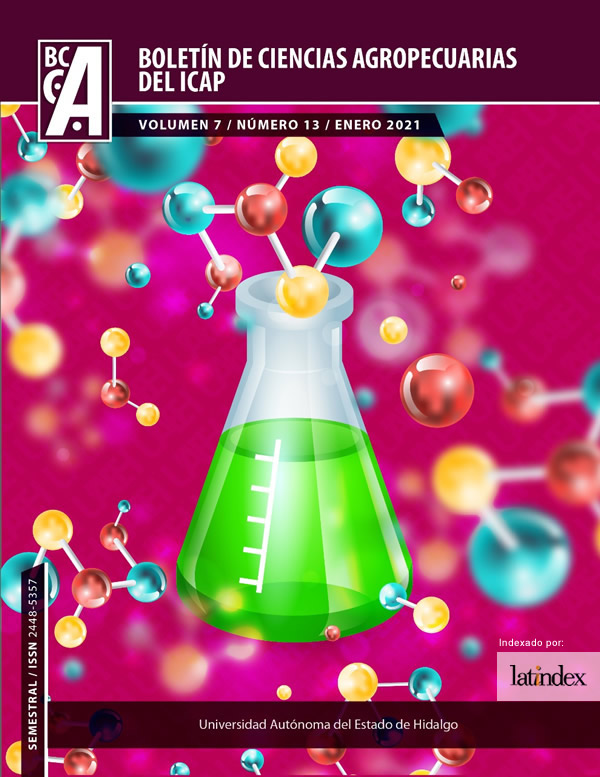Extraordinary uses for guamúchil
Abstract
Guamúchil (Pithecellobium dulce), is a tree legume, appreciated for its many uses, as well as being rustic and with high growth capacity, it is distributed throughout Mexico; which allows it to be used as a live fence, forage, land boundary, timber resource, medicinal plant, in addition to the fact that its fruit is used in Mexican gastronomy; for this reason, Pithecellobium dulce is considered to be a little-known and minimally exploited resource, so this research aims to publicize the potential uses of guamúchil.
Downloads
References
Argueta AV, Cano LMA, Rodarte ME, Gallardo MCV. Atlas de las plantas de la medicina tradicional mexicana II. 1er edición, México D.F. Instituto Nacional Indigenista 1994; 1786 pág.
Barneby RC, Grimes JW. Silk Tree, Guanacaste, Monkey's Earring: A Generic System for the Synandrous Mimosaceae of the Americas: Part II. Pithecellobium, Cojoba, and Zygia. Memoirs of The New York Botanical Garden 1997; 74(2): 1-149. ISBN-13: 978-0893274146.
Binder U. Manual de leguminosas de Nicaragua. Programa para la Agricultura Sostenible en Laderas de América Central, Estelí, Nicaragua 1997; Vol. 2, 528 pág.
Challenger A, Caballero J, Zárate SP, Elizondo RM. Utilización y conservación de los ecosistemas terrestres de México. Pasado, presente y futuro. Distrito Federal, México: Comisión Nacional para el Conocimiento y Uso de la Biodiversidad, 1998; 847 pág. ISBN: 9709000020.
Chaparro-Santiago A, Osuna-Fernández HR, Aguilón-Arenas J, Osuna-Fernández AM. Nutritional composition of Pithecellobium dulce, Guamuchil Aril. Pakistan Journal of Nutrition 2015; 14(9): 611-613. DOI: 10.3923/pjn.2015.611.613.
Colín H, Monroy R. Prontuario de árboles de selva baja caducifolia. México: Centro de Educación y Capacitación para el Desarrollo Sustentable, 1997; 79 pág. ISBN: 9688174009.
Guizar EN, Sánchez AV. Guía para el reconocimiento de los principales árboles del Alto Balsas. Distrito Federal, México: Universidad Autónoma de Chapingo, 1991; 201 pág. ISBN: 9688841374.
Juárez-Vázquez MC, Carranza-Álvarez C., Alonso-Castro AJ, González-Alcaraz VF, Bravo-Acevedo E, Chamarro-Tinajero FJ, Solano E. Ethnobotany of medicinal plants used in Xalpatlahuac, Guerrero, México. Journal of Ethnopharmacology 2013; 148(2): 521-527. https://doi.org/10.1016/j.jep.2013.04.048
Kubola J, Siriarmornpun S, Meeso N. Phytochemicals, vitamin C and sugar content of Thai wild fruits. Food Chemistry 2011; 126(3): 972-981. https://doi.org/10.1016/j.foodchem.2010.11.104
Kulkarni KV, Jamakhandi VR. Medicinal uses of Pithecellobium dulce and its health benefits. Journal of Pharmacognosy and Phytochemistry 2018; 7(2): 700-704. P-ISSN: 2349-8234. http://www.phytojournal.com/archives/2018/vol7issue2/PartJ/7-1-390-353.pdf .
Monroy R, Colín H. El guamúchil Pithecellobium dulce (Roxb.) Benth, un ejemplo de uso múltiple. Madera y Bosques 2004; 10(1): 35-53. DOI: https://doi.org/10.21829/myb.2004.1011278
Madhukar DN, Ramesh AJ. In vitro inhibitory effects of Pithecellobium dulce (Roxb.) Benth. seeds on intestinal α-glucosidase and pancreatic α-amylase. Journal of Biochemical Technology 2013; 4(3): 616-621. ISSN: 0974-2328. https://jbiochemtech.com/storage/models/article/Fn5ULAyH4rUL4G2klOxKoy8HwHj2agATPxrHRCKXsAcwVAHdi7eVsujXMW1d/in-vitro-inhibitory-effects-of-pithecellobium-dulce-roxb-benth-seeds-on-intestinal-i-glucosidase-a.pdf
Sayago-Ayerdi S, Álvarez-Parrilla E. Alimentos vegetales autóctonos iberoamericanos subutilizados. 1er Edición, Fabro Editores 2018; ISBN: 978-1-938038-10-5. http://alimentos-autoctonos.fabro.com.mx/legal.html
Pérez JP. Establecimiento y manejo de bancos de proteína. Secretaria de Agricultura, Ganadería, Desarrollo Rural Pesca y Alimentación, México, 2009; http://www.ganaderialaluna.com/pdf/Establecimientoymanejodebancosdeproteina.pdf
Pio-León JF, Díaz-Camacho S, Montes-Ávila J, López-Angulo G. Nutritional and nutraceutical characteristics of white and red Pithecellobium dulce (Roxb.) Benth fruits. Fruits 2013; 68(5): 397-408. DOI: https://doi.org/10.1051/fruits/2013084
Pío-León J F, Delgado-Vargas F, León-de la Luz JL, Ortega-Rubio A. Prioritizing wild edible plants for potential new crops based on deciduous forest traditional knowledge by a rancher community. Botanical Sciences 2017; 95(1): 47-59. DOI: 10.17129/botsci.772
Pradeepa S, Subramanian S, Kaviyarasan V. Biochemical evaluation of antidiabetic properties of Pithecellobium dulce fruits studied in streptozotocin induced experimental diabetic rats. International Journal of Herbal Medicine 2013; 1(4): 21-28. http://florajournal.com/.../3.1.pdf
Martínez RDR, Reyna LS. Estimación en caprinos del consumo de Pithecellobium dulce en un “Banco de Proteína”. CIENCIA UANL 2016; 78: 46-52. http://cienciauanl.uanl.mx/wp-content/uploads/2016/05/art.-estimacion-caprinos.pdf
Wall-Medrano A, González-Aguilar GA, Loarca-Piña GF, López-Díaz JA, Villegas-Ochoa MA, Tortoledo-Ortiz O, Olivas-Aguirre FJ, Ramos-Jiménez A, Robles-Zepeda R. Ripening of Pithecellobium dulce (Roxb.) Benth. [Guamuchil] fruit: physicochemical, chemical and antioxidant changes. Plant Foods for Human Nutrition 2016; 71(4): 396-401. https://doi.org/10.1007/s11130-016-0575-0










